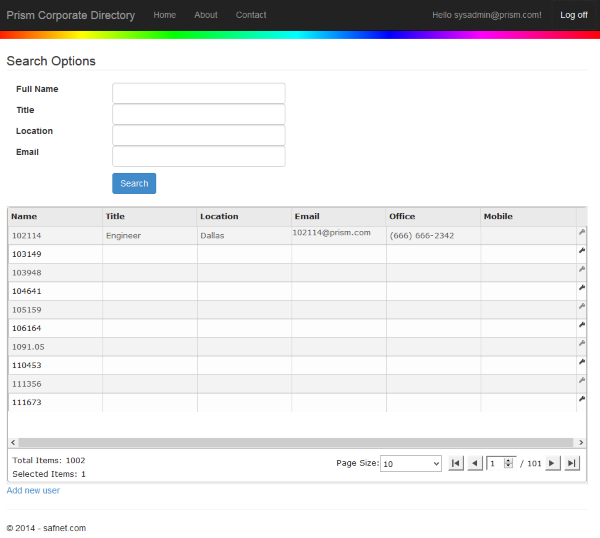Back in October I started playing around with a few technologies, resulting in my first code posted to GitHub: safnetDirectory. I must say that it is not the most impressive bit of coding that I’ve ever done. However, the urge to learn sometimes needs an unencumbered, no-strings-attached, digital canvas on which to exercise. That urge is requited through the experimentation and the lessons learned, rather than the completion of an opus.
The end result: I have a prototype of a mixed Angular.Js / ASP.Net MVC application that provides a simple directory and simple administrative functionality. And it is Hosted on Azure.

Two user stories drove this exercise, with a made-up corporate name Prism Company (I never did get around to using an engraving of Isaac Newton for the logo):
- As a Prism Company employee, I would like to lookup contact information for other employees, so that I can call or otherwise contact my co-workers as needed.
- As a Prism Company Human Resources (HR) coworker, I need to add, update, or delete employee data, so that the company directory will always be up-to-date.
To deliver these stories, I began by allowing Visual Studio 2013 to setup a basic MVC5 application with the default Membership authentication provider. From there, I modified the system by expanding the User object to include additional fields: full name, e-mail address, and phone number. Although I prefer a lighter-weight solution than Entity Framework, I left EF6 as it wasn’t critical to my goals, and using the code-first approach allowed me to concentrate on the front-end development and authentication.
The original default Registration page was modified to become the “new employee” page. I left the standard MVC bindings in place instead of using Angular because it is dealing with a small amount of data with only periodic use, and thus does not need what I consider the primary benefit of a JavaScript MVVM framework: handling large amounts of data with minimal data transmission.
Next, I used ngGrid and integrated it with the EF6 data model to create a high performing grid, with paging performed in the database rather than in JavaScript. I didn’t manage to fully customize the grid in the way I want, so perhaps at a future date I’ll upgrade to a newer version of Angular.Js and a more flexible grid component. I secured the page by integrating with the ASP.Net claims-based authentication, taking advantage of that robust toolkit instead of trying to learn something like JSON Web Token (I just happen to need to learn the ASP.Net claims authentication for work).
Finally, I added a form with search options, which is bound with Angular instead of directly using a View and Controller in ASP.Net. Still, “back-end” functionality is required to process the search request, and for that I treated an MVC Controller as a REST service, without taking the time to introduce Web API. MVC was good enough.
For now, this is just a brief reminder to myself of what I was toying with. Hopefully before the year is out I’ll find time for a follow-up to this post, going into code-level detail on how these technologies integrated. Either way, the source code is open for the world to criticize.
Posted with : Microsoft .NET, JavaScript